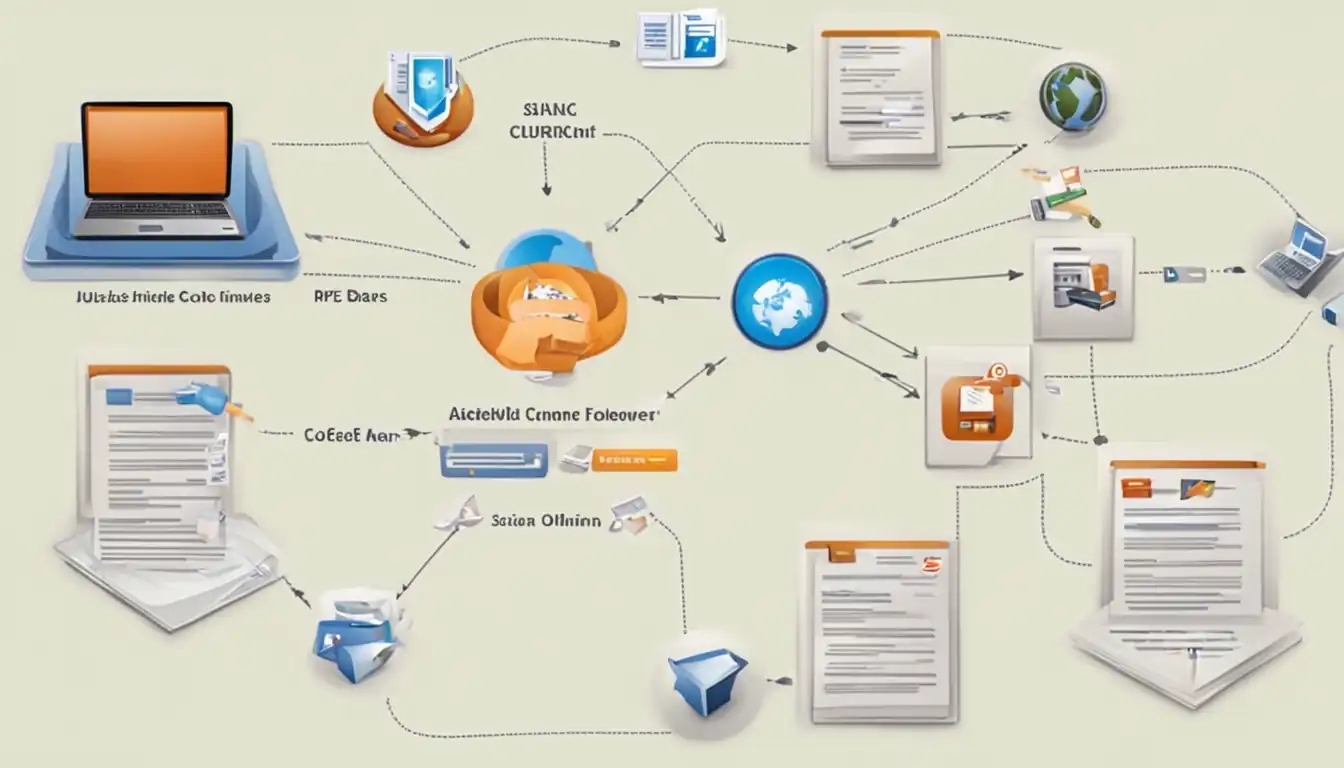The Ultimate Guide to Online Document Conversion

In today's digital age, the ability to convert documents online has become an essential tool for individuals and businesses alike. Whether you need to convert a Word document to PDF, a spreadsheet to an image, or any other file format, online document conversion offers a convenient and efficient solution. In this comprehensive guide, we will explore the ins and outs of online document conversion, its benefits, popular document formats, the conversion process, top conversion tools, quality and accuracy considerations, advanced techniques, security and privacy concerns, troubleshooting common problems, and the future of this technology.
Understanding Online Document Conversion

What Is Document Conversion?
Document conversion refers to the process of transforming a file from one format to another. This can include converting text documents, spreadsheets, presentations, images, and more. Online document conversion allows users to perform these conversions through web-based tools, eliminating the need for specialized software or technical expertise.
Why Convert Documents Online?
There are several reasons why individuals and businesses choose to convert documents online:
-
Accessibility and Convenience: Online document conversion provides easy access to conversion tools from anywhere with an internet connection. Users can convert files on the go, without the need for specific software or hardware.
-
Speed and Efficiency: Online conversion tools offer quick and efficient results, saving time compared to manual conversion methods. With just a few clicks, files can be converted in seconds.
-
Format Compatibility and Preservation: Online conversion tools ensure that files can be opened and viewed across different platforms and devices. This compatibility allows for seamless sharing and collaboration.
-
Security Considerations: Online conversion tools often prioritize data security and privacy. They employ encryption and other measures to protect sensitive information during the conversion process.
Popular Document Formats and Their Uses
Before diving into online document conversion, it's important to understand the different document formats and their specific uses. Here are some of the most common formats:
PDF: The Universal Format
Portable Document Format (PDF) is widely used for sharing and preserving documents in their original format. PDF files are viewable on any device and maintain their formatting, making them ideal for contracts, reports, and other professional documents.
DOC/DOCX: The Word Processing Standard
Microsoft Word documents, in both the older .doc format and the newer .docx format, are commonly used for creating and editing text-based documents. They are versatile and widely compatible across different word processing software.
XLS/XLSX: Spreadsheets and Data Analysis
Excel spreadsheets, in the .xls and .xlsx formats, are used for organizing and analyzing data. They offer powerful features for calculations, charts, and data manipulation, making them essential for financial analysis, budgeting, and project management.
PPT/PPTX: Presentation Powerhouse
PowerPoint presentations, in the .ppt and .pptx formats, are used to create visually appealing slideshows for educational, business, and personal purposes. They allow for easy integration of multimedia elements and are widely used for delivering presentations.
Image Formats: JPG, PNG, and More
Image formats such as JPG, PNG, GIF, and TIFF are used for storing and sharing visual content. These formats are commonly used for photographs, illustrations, and graphics, and can be converted to other formats for various purposes.
How Online Document Conversion Works
Now that we have a better understanding of document formats, let's explore how online document conversion works.
Step-by-Step Process of Converting Documents Online
-
Choose the file: Select the document you want to convert from your computer or cloud storage.
-
Select the output format: Choose the desired format you want to convert the document into.
-
Customize settings (if applicable): Some online conversion tools allow you to adjust settings such as image quality, page orientation, or compression level.
-
Initiate the conversion: Click the "Convert" button to start the conversion process.
-
Download the converted file: Once the conversion is complete, you can download the converted file to your computer or save it to your cloud storage.
Choosing the Right Online Conversion Tool
When selecting an online conversion tool, consider the following factors:
-
File format support: Ensure that the tool supports the specific formats you need to convert.
-
Ease of use: Look for a user-friendly interface that simplifies the conversion process.
-
Speed and efficiency: Choose a tool that provides fast and accurate conversions.
-
Security and privacy: Opt for a tool that prioritizes data protection and encryption.
-
Additional features: Some conversion tools offer advanced features like batch conversion, OCR technology, and customizable output settings. Consider your specific needs when evaluating these features.
Top Online Document Conversion Tools

There are numerous online document conversion tools available, both free and paid. Here are some popular options to consider:
Free vs. Paid Conversion Services
Free conversion services, such as Smallpdf and Zamzar, offer basic conversion capabilities without any cost. However, they may have limitations on file size, number of conversions, or advanced features. Paid services, like Adobe Acrobat and Nitro, provide more comprehensive features, including batch conversion, advanced formatting options, and enhanced security.
Features to Look For in a Conversion Tool
When evaluating conversion tools, consider the following features:
-
File format support: Ensure that the tool supports the formats you frequently work with.
-
Conversion speed: Look for tools that provide fast and efficient conversions.
-
Accuracy and quality: Choose a tool that maintains the integrity and formatting of the original document.
-
Security measures: Opt for tools that prioritize data protection and encryption.
-
Additional features: Consider advanced features like batch conversion, OCR technology, and customizable output settings based on your specific needs.
Comparing Popular Online Conversion Platforms
Here is a comparison of some popular online conversion platforms:
| Conversion Tool | Free Version | Paid Version | Additional Features | |-----------------|--------------|--------------|---------------------| | Smallpdf | Yes | Yes | Batch conversion, OCR | | Zamzar | Yes | Yes | API integration, file management | | Adobe Acrobat | No | Yes | Advanced formatting, document security | | Nitro | No | Yes | Collaboration tools, e-signatures |
How to Ensure Quality and Accuracy in Conversion
To ensure quality and accuracy in your document conversions, follow these tips:
Tips for Preparing Your Documents
-
Check for compatibility: Ensure that the original document is in a compatible format for the conversion tool you are using.
-
Review formatting: Double-check the formatting of your document to ensure it will be preserved during the conversion process.
-
Remove unnecessary elements: Remove any unnecessary images, tables, or other elements that may affect the conversion quality.
Common Conversion Issues and How to Avoid Them
-
Formatting errors: To avoid formatting errors, use conversion tools that prioritize maintaining the original formatting of the document.
-
Loss of data: Choose conversion tools that ensure data integrity and do not result in any loss of information during the conversion process.
-
Inaccurate conversions: Test the accuracy of the conversion tool by converting a sample document and reviewing the output.
Advanced Online Document Conversion Techniques
Beyond basic document conversion, there are advanced techniques that can enhance your conversion experience:
Batch Conversion for Multiple Files
Batch conversion allows you to convert multiple files simultaneously, saving time and effort. Look for conversion tools that offer this feature if you frequently need to convert multiple documents.
OCR Technology for Scanned Documents
Optical Character Recognition (OCR) technology converts scanned documents into editable and searchable text. This is particularly useful when converting physical documents or images with text.
Customizing Output Settings for Specific Needs
Some conversion tools allow you to customize output settings based on your specific requirements. This includes adjusting image quality, page orientation, compression level, and more.
Security and Privacy in Online Document Conversion

When converting documents online, it's crucial to prioritize security and privacy. Consider the following:
Understanding Encryption and Data Protection
Ensure that the conversion tool you choose employs encryption methods to protect your data during the conversion process. Look for tools that comply with industry standards and regulations.
Best Practices for Protecting Your Documents
To protect your documents during online conversion, follow these best practices:
-
Use reputable conversion tools: Choose tools that have a proven track record of prioritizing security and privacy.
-
Avoid sharing sensitive information: Remove any sensitive or confidential information from documents before converting them.
-
Secure your internet connection: Use a secure network connection, such as a VPN, when converting documents online.
Troubleshooting Common Online Conversion Problems

Despite the convenience of online document conversion, you may encounter some common problems. Here's how to troubleshoot them:
Dealing with Formatting Errors
If you encounter formatting errors during the conversion process, try the following:
-
Use a different conversion tool: Switch to a different tool that is known for preserving formatting.
-
Adjust settings: Experiment with different output settings to see if it resolves the formatting issues.
Handling Large File Sizes
If you are dealing with large file sizes that are causing conversion problems, consider the following solutions:
-
Compress the file: Use compression tools or software to reduce the file size before converting.
-
Split the document: Divide the document into smaller sections and convert them individually.
Overcoming Compatibility Issues
If you encounter compatibility issues during conversion, try the following:
-
Update software: Ensure that you have the latest version of the software or conversion tool.
-
Convert to an intermediate format: Convert the document to a more compatible format first, and then convert it to the desired format.
The Future of Online Document Conversion

As technology continues to evolve, so does online document conversion. Here are some emerging technologies and trends to watch for:
Emerging Technologies and Trends
-
Artificial Intelligence (AI): AI-powered conversion tools can analyze and understand the content of documents, improving accuracy and efficiency.
-
Cloud-based conversion: Cloud-based conversion allows for seamless collaboration and access to conversion tools from any device.
The Role of AI in Document Conversion
AI has the potential to revolutionize document conversion by automating processes, improving accuracy, and enhancing user experience. AI-powered tools can analyze document content, extract data, and optimize conversions based on user preferences.
Conclusion: Maximizing Efficiency with Online Document Conversion
Online document conversion offers a convenient and efficient way to transform files from one format to another. By understanding the benefits, popular document formats, the conversion process, top conversion tools, quality and accuracy considerations, advanced techniques, security and privacy concerns, troubleshooting common problems, and the future of this technology, you can maximize efficiency and productivity in your document conversion endeavors.
Additional Resources and Further Reading
For more information on online document conversion, check out the following resources: